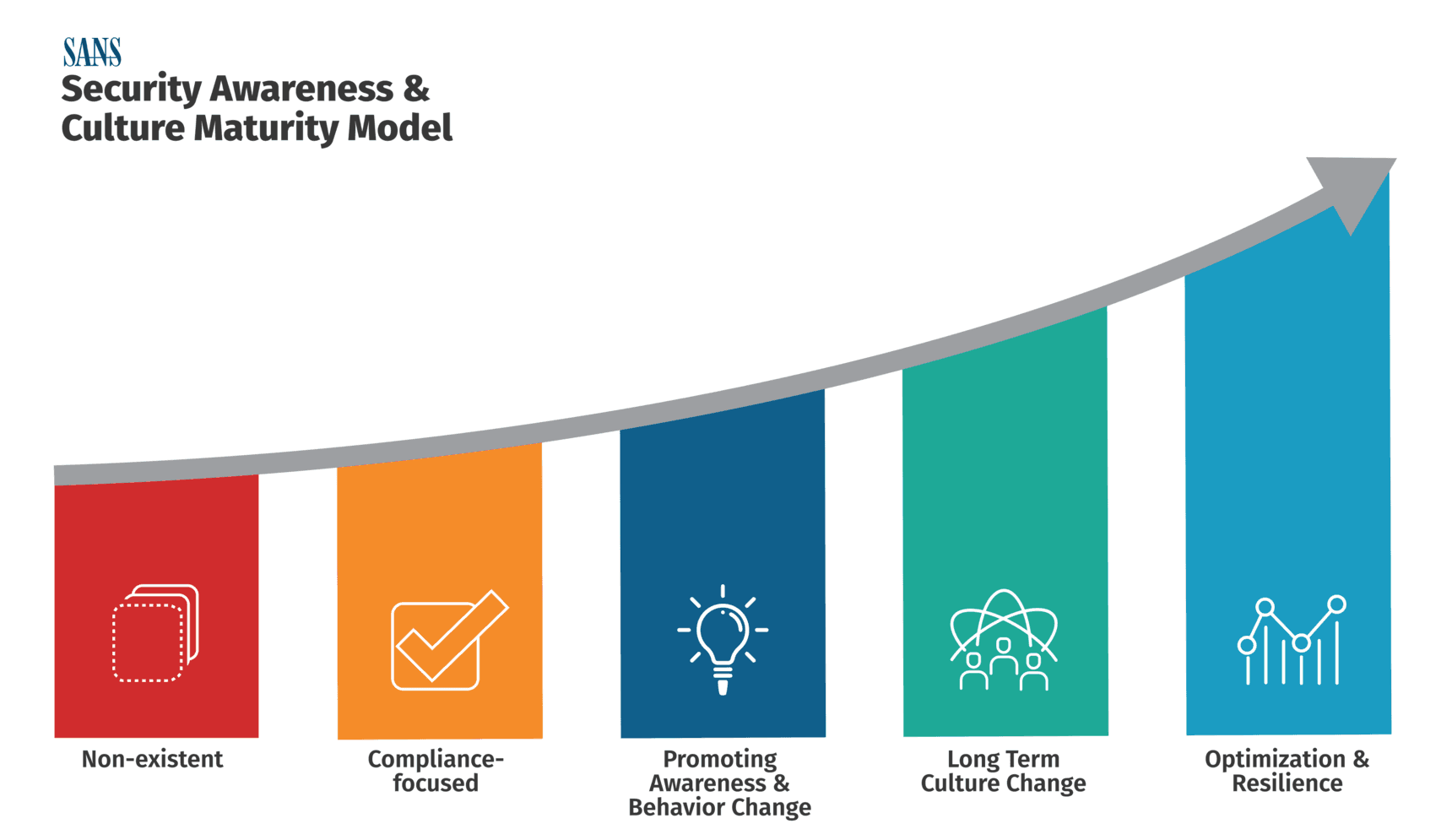SEC595: Applied Data Science and AI/Machine Learning for Cybersecurity Professionals


Experience SANS training through course previews.
Learn MoreLet us help.
Contact usBecome a member for instant access to our free resources.
Sign UpWe're here to help.
Contact UsDespite years of investment in expanding their technology stacks, healthcare organizations continue to fall victim to high-impact cyberattacks.

Editor’s Note:
This blog offers a preview of the updated SANS Security Awareness and Culture Maturity Model, which will be featured in full in the upcoming 2025 SANS Security Awareness Report, launching August 13. The model is introduced in the section “Cultivating a Culture That Mitigates Risk” and provides a structured, practical path for advancing organizational security culture and reducing human risk. For healthcare leaders seeking to improve cybersecurity maturity, it highlights actionable steps to move beyond compliance-based training and build a resilient, security-minded workforce.
The KLAS Cybersecurity Solutions for Healthcare 2025 Report found that healthcare organizations are over-relying on technology to drive cybersecurity maturity. This calls for a shift in focus from technology to one that also include the human element. As organizations get better at using technology to secure their environments, people have become the primary attack vector.
Despite years of investment in expanding their technology stacks, healthcare organizations continue to fall victim to high-impact cyberattacks. For example, Episource, the medical billing giant owned by a subsidiary of UnitedHealth, announced this month that it suffered a data breach in February 2025, exposing the personally identifiable information (PII) of more than 5.4 million people. And they weren’t alone. In the first half of 2025, the Identity Theft Resource Center reported 283 healthcare data breaches, up nearly 20% in the same period in 2024. Healthcare breaches haven’t stopped, nor have the operational disruptions, delayed patient care, and regulatory pressures that follow them.
It's not due to a lack of tools. In fact, more than half of healthcare organizations polled in a HIMSS Healthcare Cybersecurity Survey planned to increase security spending in 2025. However, it’s important to understand that technology alone doesn’t drive maturity. According to the latest KLAS Cybersecurity Solutions for Healthcare 2025 Report, most healthcare security vendors remain focused on infrastructure tools like cloud security, endpoint protection, network segmentation, and identity. These capabilities dominate the landscape of reported offerings. But when healthcare CISOs were asked about their greatest obstacles to maturity, the answer was not technology gaps, it stemmed from a lack of staffing and skill expertise.
That disconnect reflects a broader issue facing the industry: many maturity conversations are still centered on products over people. The KLAS report also found that while demand is growing for managed services such as SOC support and third-party risk management, very few vendors offer services that directly address the human layers of security, things like awareness training, behavioral simulations, and workforce operational readiness.
To drive real, measurable maturity, organizations must shift their focus from just technology to prioritizing the human element: the security professionals managing risk and the broader workforce whose daily actions influence exposure. This is where SANS can serve as a key partner to the healthcare industry. Listed as a top contributor in the KLAS report's proactive security and workforce readiness categories, SANS was recognized for delivering structured training and simulation programs that help healthcare organizations build readiness and close critical maturity gaps.
Healthcare security teams operate in complex environments where timing, coordination, and technical judgment directly affect outcomes. Between legacy systems, third-party dependencies, and constant alert volume, even adequately staffed teams can struggle to maintain control.
SANS training is designed to help alleviate that complexity and drive higher levels of practitioner efficiency in the areas that matter most. Courses focus on building operational fluency, how to lead response workflows during incidents, implement controls effectively, and align tactical decisions with broader business goals. The curriculum is execution-focused, with scenario-based learning and immediate applicability. For example:
Explore the full list of SANS course and certification offerings here.
Organizations that adopt SANS training see measurable returns on their investment. In a recent SANS-sponsored IDC study The Business Value of SANS: Proven Impact of Cybersecurity Training, teams that trained with SANS detected incidents 50% faster, contained them 4.2 times faster, and recovered 2.6 times faster than their non-trained peers. These kinds of improvements translate directly to fewer disruptions, tighter containment windows, and less pressure on response teams.
In a healthcare setting, that can mean the difference between a manageable event and operational downtime that puts patients at risk. Over time, it also builds internal leadership capacity, reducing over-reliance on senior staff and improving overall team resilience.
Security failures rarely begin in the SOC. They start with an overlooked alert, a misplaced click, or a missed opportunity to report something that didn’t feel right. For healthcare organizations where workflows are fast and distributed, employees often encounter threats before the security team does. That’s why cultivating a strong organizational culture of cyber hygiene is foundational to achieving maturity.

The SANS Security Awareness and Culture Maturity Model offers a structured path for building that culture. It defines five stages of maturity, showing how organizations evolve from baseline training to proactive security culture embedded in day-to-day operations:
Most healthcare organizations are in Stage 2 or early Stage 3. They have training, but it hasn’t yet translated into measurable behavior change. Advancing further requires changing how security is communicated, reinforced, and led. By leveraging the SANS model, CISOs can identify why their awareness programs underperform, make proven adjustments, and communicate results to earn leadership buy-in.
A strong security culture doesn’t form on its own. It grows through repeated contact, leadership modeling, and meaningful measurement. The organizations that successfully move up the maturity curve are those that treat the human element as their first line of defense. When technical teams are equipped to execute and the broader workforce is engaged in reducing risk, organizations gain the agility and resilience required to manage today’s threats.
SANS provides the training frameworks and cultural benchmarks you need to get there.
Visit https://www.sans.org/why-work-with-sans/ to learn more.
The full details of the updated model, including new guidance for measuring cultural maturity and advancing program impact, will be available in the 2025 SANS Security Awareness Report, which will be released on August 13.


Lance revolutionized cyber defense by founding the Honeynet Project. At SANS, he has empowered over 350 organizations worldwide to build resilient security cultures, transforming human risk management into a cornerstone of modern cybersecurity.
Read more about Lance Spitzner